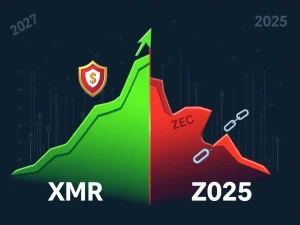Revolutionary: Binance Unleashes Treasury-Backed USYC on BNB Chain, Powering DeFi’s RWA Evolution

Imagine a world where the rock-solid stability of U.S. Treasury bonds meets the innovative, permissionless power of decentralized finance. This isn’t a distant dream; it’s becoming a tangible reality thanks to a groundbreaking move by Binance. The global crypto giant has announced the deployment of Circle’s interest-bearing stablecoin, USYC, on the BNB Chain, marking a significant stride in integrating real-world assets (RWAs) into decentralized finance (DeFi) ecosystems. This strategic integration of Binance USYC is set to reshape the landscape of digital finance, offering a new paradigm of stability and credibility.
Binance USYC: A Game-Changer for DeFi Stability?
Binance’s decision to bring Circle’s USYC to the BNB Chain is more than just another token listing; it’s a profound statement about the future direction of DeFi. USYC, distinctively collateralized by U.S. Treasury bonds, aims to enhance the credibility and scalability of DeFi protocols on the BNB Chain, which stands as the second-largest smart contract platform by transaction volume. This initiative aligns perfectly with the burgeoning industry trend of tokenizing traditional assets, effectively bridging conventional finance with the dynamic world of decentralized markets.
By leveraging U.S. government-backed collateral, this move directly addresses long-standing criticisms of DeFi’s susceptibility to volatility and counterparty risks. Unlike algorithmic stablecoins that rely on complex, often fragile mechanisms, or privately held alternatives with opaque reserves, USYC offers a tangible, low-risk reserve asset. This positions the BNB Chain as a pivotal hub for blending blockchain’s inherent programmability with sovereign-backed assets, offering an institutional-grade level of stability that many in the traditional finance sector have been waiting for.
Why is RWA Adoption the Next Frontier for DeFi?
The integration of real-world assets into blockchain ecosystems is widely regarded as the next evolutionary phase for decentralized finance. For years, DeFi has thrived on crypto-native assets, but its growth potential has often been limited by the inherent volatility and lack of direct connection to the global economy’s vast wealth. RWA adoption changes this narrative entirely. It brings tangible value, regulatory clarity, and institutional liquidity to the blockchain, promising to unlock trillions of dollars in value currently locked in traditional markets.
The benefits of tokenizing RWAs are manifold:
- Enhanced Stability: By backing digital assets with physical or financial assets, the volatility often associated with cryptocurrencies can be significantly reduced.
- Increased Liquidity: RWAs, once tokenized, can be traded 24/7 on global blockchain networks, increasing their accessibility and liquidity.
- Broader Investor Base: Tokenized RWAs can attract institutional investors and traditional finance participants who are wary of crypto’s volatility but are interested in the efficiency and transparency of blockchain.
- New DeFi Use Cases: RWAs can be used as collateral for lending, borrowing, and other financial primitives, expanding the utility and depth of DeFi protocols.
- Regulatory Compliance: Many RWAs come with established legal frameworks, which can help guide the development of compliant blockchain solutions.
Boosting BNB Chain DeFi: A Strategic Move
The deployment of USYC on BNB Chain underscores Binance’s strategic focus on institutional-grade stability and hybrid financial systems. This effort also reflects Binance’s broader goal of expanding the utility of its native token beyond mere trading fees and governance, fostering significant ecosystem growth through strategic partnerships. For BNB Chain DeFi, this integration is a massive win.
BNB Chain’s emphasis on speed, low fees, and enterprise collaboration positions it strongly to attract institutions seeking cost-effective solutions for RWA tokenization. By anchoring USYC to U.S. Treasury bonds, Binance actively mitigates regulatory risks often associated with privately issued stablecoins, aligning with evolving global standards for crypto oversight. This move signals BNB Chain’s ambition to fiercely compete with Ethereum and other Layer 1 platforms in the burgeoning RWA space, offering a robust and scalable infrastructure for these new financial instruments.
The Power of a Treasury-Backed Stablecoin: USYC’s Unique Edge
Unlike many existing stablecoins, USYC stands out because it is a Treasury-backed stablecoin. This means its value is directly tied to and collateralized by U.S. Treasury bonds, considered one of the safest and most liquid assets globally. This fundamental difference offers several compelling advantages:
- Unparalleled Security: Backing by U.S. government debt instruments provides a level of security and trust that few other digital assets can match.
- Yield Potential: As USYC is backed by interest-bearing Treasury bonds, it opens the door for potential yield generation for holders, a feature that could make it highly attractive in DeFi protocols. While specific terms for yield-generating mechanisms haven’t been fully disclosed by Binance, the underlying asset inherently possesses this capability.
- Reduced Counterparty Risk: The collateral is held in a highly regulated and transparent manner, reducing the risks associated with private reserves.
- Institutional Appeal: The familiar and trusted nature of Treasury bonds makes USYC particularly appealing to large institutional investors and traditional financial firms looking to enter the DeFi space with minimal risk exposure.
Analysts note that the ultimate success of USYC will heavily depend on its widespread adoption by DeFi developers and users, particularly in critical areas like lending, borrowing, and liquidity provision. The competitive advantages compared to alternatives like USDC or DAI will need to materialize clearly, especially regarding yield generation and seamless integration.
Unlocking the Potential of Real-World Assets in Crypto
The partnership with Circle, a recognized leader in stablecoin issuance, lends significant credibility to BNB Chain’s ambitious RWA agenda. Binance’s press release highlights this initiative as a cornerstone of its roadmap to accelerate real-world assets development through cutting-edge blockchain innovation. While the absence of detailed financial projections or specific partnership timelines raises some questions about immediate scalability, the strategic intent is clear: to position BNB Chain at the forefront of the RWA revolution.
The implications of such integrations are vast. Imagine fractional ownership of real estate, commodities, or even intellectual property, all traded seamlessly and transparently on a blockchain. This could democratize access to high-value assets, reduce intermediaries, and create entirely new markets. The journey of RWAs in DeFi is just beginning, and with major players like Binance and Circle leading the charge, the pace of innovation is set to accelerate dramatically.
Conclusion: A New Era for DeFi and Traditional Finance
Binance’s integration of Circle’s U.S. Treasury-backed USYC on the BNB Chain marks a pivotal moment for both decentralized finance and traditional financial markets. By bringing the stability and credibility of sovereign-backed assets to the blockchain, this move not only addresses critical challenges within DeFi but also paves the way for unprecedented institutional participation. It’s a bold step towards a future where the lines between traditional and decentralized finance blur, creating a more robust, stable, and accessible global financial ecosystem. As this integration unfolds, the crypto world will be watching closely to see how USYC on BNB Chain truly catalyzes the widespread adoption of real-world assets, ushering in a new era of financial innovation.
Frequently Asked Questions (FAQs)
What is USYC?
USYC is an interest-bearing stablecoin developed by Circle, which is fully collateralized by U.S. Treasury bonds. This backing by highly liquid and secure government debt aims to provide superior stability and credibility compared to other stablecoins.
How does USYC differ from other stablecoins like USDC or USDT?
While USDC and USDT are also pegged to the U.S. dollar, USYC’s key differentiator is its direct backing by interest-bearing U.S. Treasury bonds. This structure not only provides a high level of security but also offers the potential for yield generation, making it a unique offering in the stablecoin market.
What are Real-World Assets (RWAs) in DeFi?
Real-World Assets (RWAs) in DeFi refer to tangible or intangible assets from the traditional financial world—such as real estate, commodities, stocks, bonds, or even intellectual property—that are tokenized and brought onto a blockchain. This allows them to be used within decentralized finance protocols, enabling new use cases like collateralized lending or fractional ownership.
What are the benefits of integrating USYC on BNB Chain?
Integrating USYC on BNB Chain enhances the platform’s stability and credibility, attracts institutional investors due to its Treasury backing, and expands the utility of DeFi protocols by providing a low-risk, yield-potential collateral asset. It also positions BNB Chain as a leader in the RWA space, leveraging its speed and low fees.
What challenges does RWA adoption face in DeFi?
Despite the immense potential, RWA adoption faces challenges such as regulatory uncertainty across different jurisdictions, the need for robust legal frameworks to link digital tokens to physical assets, and ensuring sufficient liquidity and adoption by both developers and users within DeFi ecosystems.
How can users access or utilize USYC on BNB Chain?
Once fully deployed and accessible, users will likely be able to acquire USYC through exchanges that support it on BNB Chain. Its utility will extend to various DeFi protocols for activities like lending, borrowing, providing liquidity to decentralized exchanges, and potentially earning yield from its underlying Treasury bond collateral, depending on the specific mechanisms implemented by Binance and Circle.









